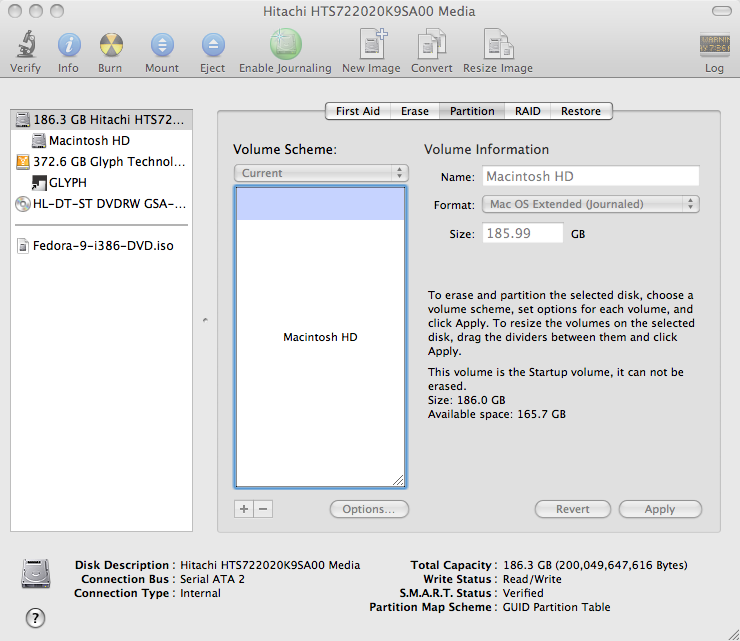MacTel PlanetCCRMA
Installation instructions for a MacBook Pro
Main steps:
1) Backup your data.
2) Partition your OS X drive.
3) Install boot loader.
4) Install (& update) Linux, first adding boot, Linux, and swap partitions.
5) PlanetCCRMA-lize your Linux.
Contents
Acquiring Fedora Media
You can borrow Install DVD's from SysAdmin anytime. You can also download your own to your Mac, by visiting Fedora. You can save a bunch of time and consternation by checking the media integrity right away. Use the following command line to determine the SHA1SUM checksum (takes a few minutes). Compare this output string to the one provided by Fedora [1]. Ignore the verify instructions on that page, they are for Linux, but you can find the checksums here: 'Install DVD/Rescue CD > i386' The checksums strings should match exactly. If not, you've got a corrupt download, and you'll have to try again. This doesn't happen often, but it's worth the extra few minutes.
openssl dgst -sha1 Fedora-9-i386-DVD.iso
Burn it to DVD with Disk Utility: Images > Burn ... Disk Utility can be found here: /Applications/Utilities/Disk Utility
Prep the Mac, Start Fedora Installation
1. Update firmware (run software update or download latest OS from Apple)
2. Plug into power source; connect to internet via Ethernet.
2. Start OS X Disk Utility (Utilities menu): select top hard drive icon, click "Partition" tab.
You can now change the size of your Mac HD partition: select size, click "Apply", wait (can take some time).
<image>
<image>
3. Custom install rEFIt, making sure to select "rEFIt File System Drivers".
<image>
Restart to check rEFIt install (might take 2 reboots, rEFIt screen shows before OSX boot).
4. Start installation of Fedora 8 (32-bit version from DVD -- get from CCRMA sys admin) -- restart and boot from DVD (select Linux penguin as option from rEFIt menu). Note: beware of trackpad sensitivity. This part takes about 30 minutes.
On DVD installer boot: Select first option "Install or upgrade an existing system". Skip disk check. Fedora installation app starts. Choose language and keyboard.
Boot, Linux, & Swap Partitioning
5. Partitioning:
First dropdown menu: Create custom layout; click "Next". New window: click on free partition box; click "New".
Make 3 partitions:
1-Boot partition: /boot mount point, ext3 filesystem, select 200MB fixed size; click "OK".
2-Linux partition: /boot mount point, ext3 filesystem, select fixed size you want in MB (eg: 84000 = 84GB); click "OK".
3-Swap partition: swap filesystem, select fixed size (RAM size x 2); click "OK".
Click "Next", accept defaults for next few sections.
Finish Fedora Install & Update, PlanetCCRMA-lization
6. Finish Fedora installation -- click "Next" to install Fedora.
7. Reboot computer, choose Linux Penguin icon from rEFIt menu, boot into Linux, follow instructions to do system setup.
8. Update Fedora: while plugged into Ethernet internet, in a terminal as root (su) type:
~> yum upgrade
This can take two hours or more, depending on size & download speed.
8. PlanetCCRMA Fedora 8 installation
9. Soundcard detection via: System>Administration>Soundcard Detection.
References
rEFit boot loader What is EFI [2]?
Fedora8 on MacBook Pro (Santa Rosa 3,1)
